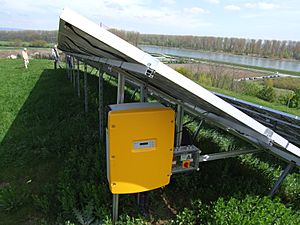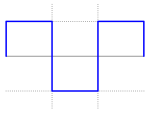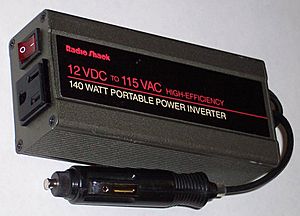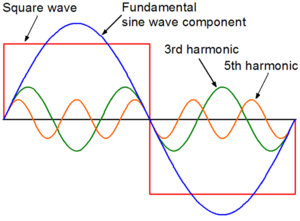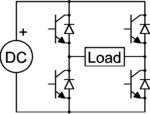Power inverter facts for kids
A power inverter is a cool electronic device. It changes direct current (DC) electricity into alternating current (AC) electricity. Think of it like this: DC is like a one-way street for electricity, while AC is like a two-way street. Most of our home appliances use AC power.
Inverters do the opposite of devices called rectifiers. Rectifiers change AC into DC. An inverter doesn't create electricity. It just takes DC power from a source, like a battery, and changes it into AC power. The way it's designed decides the output voltage and how much power it can handle.
Some inverters are fully electronic. Others might mix mechanical parts with electronic circuits. Static inverters are special because they don't have any moving parts to do the conversion.
Inverters are mostly used for electrical power where there are high currents and voltages. For smaller electronic signals, which have very low currents, similar devices are called oscillators.
Contents
How Inverters Work
Input Power
An inverter needs a steady source of DC power. This source must be strong enough to provide all the power the inverter needs. The input voltage can be different depending on what the inverter is used for:
- 12 V DC: This is common for smaller inverters. They usually run from a 12 V car battery or a special car power outlet.
- 24, 36, or 48 V DC: These are standard for home energy systems, like those with solar panels.
- 200 to 400 V DC: This is used when power comes directly from photovoltaic solar panels.
- 300 to 450 V DC: Electric cars use this when they send power back to the grid.
- Hundreds of thousands of volts: Very large inverters use this for high-voltage direct current (HVDC) power lines.
Output Power Shapes
The AC power an inverter creates can have different shapes, called waveforms. The most common shapes are square wave, modified sine wave, and pure sine wave. The "purity" of a sine wave is measured by something called total harmonic distortion (THD). A lower THD means a smoother, cleaner wave.
Square Wave
This is the simplest shape an inverter can make. It's like turning the power completely on and off very quickly. Square waves are good for simple things like lights or heaters. But they can make a "humming" noise if connected to audio equipment. They are not usually good for sensitive electronics.
Pure Sine Wave
A pure sine wave inverter makes AC power that looks very much like the power you get from the wall outlets at home. This is the best type of power for most electrical products. Many devices are designed to work perfectly with a pure sine wave.
Pure sine wave inverters are more complex and usually cost more. But they are better for sensitive electronics. Things like computers or DVD players can work on other wave types. But AC motors might get hotter or make more noise if they don't get a pure sine wave.
Modified Sine Wave
A modified sine wave is a bit like a mix between a square wave and a pure sine wave. It's made by combining two square waves. This makes the power shape closer to a smooth sine wave than a simple square wave. Most cheaper inverters for everyday use make a modified sine wave.
Many electrical devices work fine with modified sine wave power. This is especially true for things that just use heat, like light bulbs. Devices with a switch-mode power supply (like phone chargers or laptop power bricks) also usually work well. However, some devices might run less efficiently or make a humming noise. This is because the modified sine wave isn't as smooth.
Near Sine Wave PWM
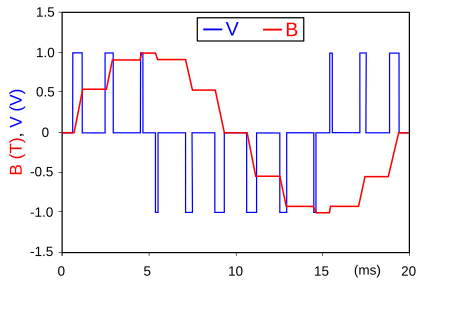
Some advanced inverters use a method called PWM. This means they switch the power on and off very, very fast (many thousands of times per second). By changing how long the power is "on" in each tiny pulse, they can create a waveform that can be smoothed out to become a near-perfect sine wave. This method allows for very good control over the power quality.
Output Frequency
The AC output frequency of an inverter is usually the same as standard home power, which is 50 or 60 hertz. But for controlling motors, the inverter can change the frequency. This allows the motor to run at different speeds.
Output Voltage
The AC output voltage is often set to match the voltage from your wall outlets, like 120 or 240 VAC. This lets the inverter power many devices designed for regular home use. Some inverters even let you choose or change the output voltage.
Output Power
An inverter has a power rating, usually in watts or kilowatts. This tells you how much power it can provide to the devices you connect. It also tells you how much power it will need from its DC source. Smaller inverters for home use usually range from 150 to 3000 watts.
Batteries for Inverters
If an inverter runs on batteries, how long it lasts (its runtime) depends on two things: how much power the batteries have and how much power you are using from the inverter. The more devices you plug in, the faster the batteries will run out. To make the inverter run longer, you can add more batteries.
Here's a simple way to figure out how much battery capacity you need:
- Battery Capacity (Ah) = Total Power Used (in Watts) X Time Needed (in hours) / Input Voltage (V)
When adding more batteries, you have two main choices:
- Series connection
- If you want to increase the total voltage going into the inverter, you can connect batteries in a series. This is like stacking them up. But if one battery fails, the whole chain stops working.
- Parallel connection
- If you want to increase how long the inverter runs (its capacity), you can connect batteries side-by-side in parallel. This increases the total ampere hour (Ah) rating. However, if one battery gets fully drained, it can cause the other batteries to drain quickly into it, which can be dangerous. Special circuits are used to prevent this.
What Inverters Are Used For
Using DC Power Sources
Inverters are great for converting DC power from sources like batteries or fuel cells into AC power. This means you can power regular AC appliances even when you're away from the main power grid.
Uninterruptible Power Supplies (UPS)
An uninterruptible power supply (UPS) uses batteries and an inverter. If the main power goes out, the UPS instantly switches to battery power using its inverter. This keeps your devices running without interruption. When the main power comes back, the UPS recharges its batteries.
Controlling Electric Motor Speed
Inverters are often used to control the speed of electric motors. They can change the voltage and frequency of the AC power they send to the motor. This is useful for many things, like:
- Industrial machines
- Electric vehicles
- Trains
- Power tools
In Refrigeration Compressors
Inverters are used in modern refrigerators and air conditioning systems. They control the speed of the compressor motor. Older systems just turn the compressor on and off. Inverter systems can run the compressor at different speeds. This makes them much more efficient and saves energy. The first air conditioners with inverters came out in Japan in 1981.
Power Grid Connection
Grid-tied inverters are special inverters that send power into the main electricity grid. They have to match the grid's power perfectly and produce a very clean waveform. They also have safety features to stop sending power if the grid goes down.
Very large inverters, sometimes hundreds of megawatts, are used in high voltage direct current (HVDC) power transmission systems. They convert the DC power back to AC power for cities and homes.
Solar Power Systems
A solar inverter is a key part of a photovoltaic system (solar panels). It takes the DC power from solar panels and turns it into AC power. This AC power can then be used in your home or sent to the power grid. Solar inverters have special features, like finding the best power output from the panels.
Some solar systems use micro-inverters. These are small inverters attached to each individual solar panel. This can make the whole system more efficient. The power from many micro-inverters is then combined.
Induction Heating
Inverters are used in induction heating systems. They convert regular AC power into much higher frequency AC power. This high-frequency power is used to heat metals very quickly and efficiently.
HVDC Power Transmission
In HVDC power transmission, AC power is first changed to high-voltage DC power. This DC power is sent over long distances. At the other end, a large inverter changes the power back to AC for local use.
Electroshock Weapons
Electroshock weapons and tasers use small inverters. They take a small DC battery voltage (like 9V) and turn it into tens of thousands of volts of AC. This high voltage is then stored and released in a powerful pulse.
Other Uses
- Portable power: Inverters let you use a battery to power things like lights, TVs, kitchen appliances, and power tools when you're camping or during a power outage.
- Frequency conversion: If you're in a country with 50 Hz power and need to run a device that requires 60 Hz, an inverter can change the frequency for you.
How Inverter Circuits Are Designed
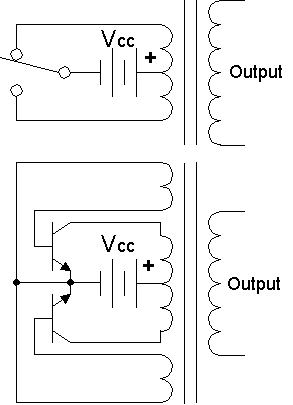
Basic Design
A very simple inverter circuit uses a transformer and a switch. DC power goes into the middle of the transformer's main coil. A switch rapidly flips back and forth, sending current through one side of the coil, then the other. This constant switching makes the magnetic field in the transformer change direction, which then creates AC power in the transformer's output coil.
Older inverters used mechanical switches, like a "vibrator" or "buzzer." These were used in old car radios. Today, modern inverters use electronic switches like transistors or thyristors (SCRs). These electronic switches can turn on and off much faster and handle more power.
When a simple switch is used without a special output transformer, it creates a square wave. This is because the power is just "on" or "off." To get a smoother wave, like a sine wave, engineers use filters (made of capacitors and inductors) to clean up the square wave.
Advanced Designs
There are many advanced ways to design inverters. These designs solve different problems depending on what the inverter is used for. For example, in an electric car, a special inverter can even send power back to the battery when the car slows down.
One common design is called an H-bridge. It uses four switches to control the direction of current flow. By turning these switches on and off in different patterns, the inverter can create different output waveforms.
One way to control an H-bridge is to switch it at the same frequency as the AC power you want. Another way is to use PWM. With PWM, some switches turn on and off very quickly (like 100,000 times per second). This creates many tiny pulses that, when smoothed out, form a sine wave.
The quality of the waveform is very important. Filters (using capacitors and inductors) are used to make the waveform smoother. These filters let the main part of the wave pass through while blocking the unwanted parts (harmonics).
Making a Sine Wave Even Better
Some inverters use resonant circuits to create very clean sine waves. These circuits use special combinations of inductors and capacitors to remove unwanted parts of the waveform. This method is often used in large UPS systems for data centers, where power quality is super important.
Three-Phase Inverters
Three-phase inverters are used for very powerful applications, like controlling large motors or in HVDC power transmission. They have three sets of switches, one for each phase of the power. This creates a smoother, more powerful output.
To make even more powerful inverters, engineers can connect several three-phase inverters together. This increases the total power they can handle and also makes the output waveform even cleaner.
Size of Inverters
Compared to many other home electronics, inverters can be quite large. In 2014, Google and IEEE even held a competition called the Little Box Challenge. They offered a $1,000,000 prize to anyone who could build a much smaller power inverter.
History of Inverters
Early Inverters
Before modern electronics, people used big machines to change DC power to AC. These were called rotary converters or motor-generator sets. They had electric motors connected to generators. In the early 1900s, special vacuum tubes also started to be used as switches in inverter circuits.
The word "inverter" comes from these early machines. AC-to-DC converters were common. If you ran them backward (inverted their operation), they would change DC to AC. So, they were called "inverters" because they inverted the job of a converter.
Modern Inverters
The invention of the thyristor (also called a silicon-controlled rectifier or SCR) in 1957 was a big step. It allowed engineers to build inverters using solid state electronics (no moving parts or vacuum tubes). SCRs could handle a lot of power.
Today, most inverters use transistors or IGBTs (Insulated Gate Bipolar Transistors). These are even better because they can be turned on and off easily with control signals. This makes modern inverters much more efficient and reliable.
 In Spanish: Inversor (electrónica) para niños
In Spanish: Inversor (electrónica) para niños
See Also
- CCFL inverter
- Distributed inverter architecture
- Electrical power converter
- Electronic oscillator
- Pallet inverter
- Push–pull converter
- Space vector modulation
- Switched-mode power supply (SMPS)
- Synchronverter
- Uninterruptible power supply
- Variable-frequency drive
- Z-source inverter


